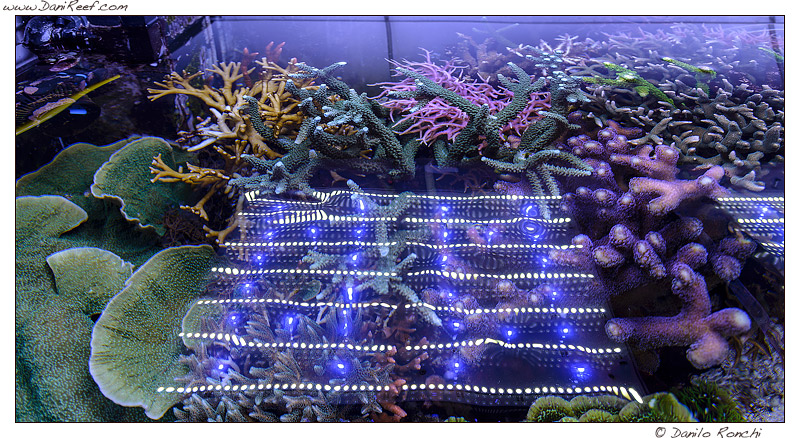
After a long journey that began in January 2013 we are finally ready to talk in detail of the LED fixture Sicce GNC AM 466.
The major feature of this lamp is to employ a very large number of low power LEDs, in contrast to the greater number of light fixtures sold in the market that have a few high-power LEDs. In this way you have less problems of overheating of the LED die, a greater longevity of the light fixture itself, and a very diffuse light, very similar to the one created by neon T5, although the effect of the reverberation, the so-called “glitter lines”, is totally lost.
There is no danger, however, to see the spot of the LED reflections in the water and there are no lenses to direct the flow of the LEDs, as it should be in a ceiling light with such a large number of LEDs.
Specifications
The LEDs are a total of 420, 392 white and 28 blue, with 120 watt consumption reported by sicce.
The weight is 5.8kg for a size of 466x366x50 (h) mm.
The purchase price amounted to € 1,592 in Italy for a single ceiling light, a system similar to what we had in our test then it would cost € 3,194, an extremely high price which we will discuss in the bottom of the article after examining in detail the ceiling.
The line is extremely stringy and the construction of the ceiling lamp is excellent.
Side view is amazing for its slimness and well built.
Design
The sicce GNC AM466 is built in an extremely simple manner, and, because of the materials used, can be easily guessed. The core of the LEDs are in fact mounted on a huge aluminum cooling heatsink, drowned on a transparent plexiglass plate, that even after ten months of use has remained extremely transparent. The plexiglas plate serves to protect the LEDs and to operate the passive cooling channels, given that the ceiling does not mount any type of fans or active cooling devices. The ceiling light is also waterproof, with the only critical point represented by the electrical plug.
The building, as can be seen from the pictures is absolutely impeccable and of the highest quality.
Setting
The installation of the light fixture is extremely simple. There are no moving parts and the connection kit to the ceiling is made up of four steel wires for each fixture. sicce also made available one template so you can easily get the holes in the ceiling at the right distance.
Having four wires for each fixture, the management of the parallelism is extremely simple and you can put the two ceiling lights in the right position in a very short time.
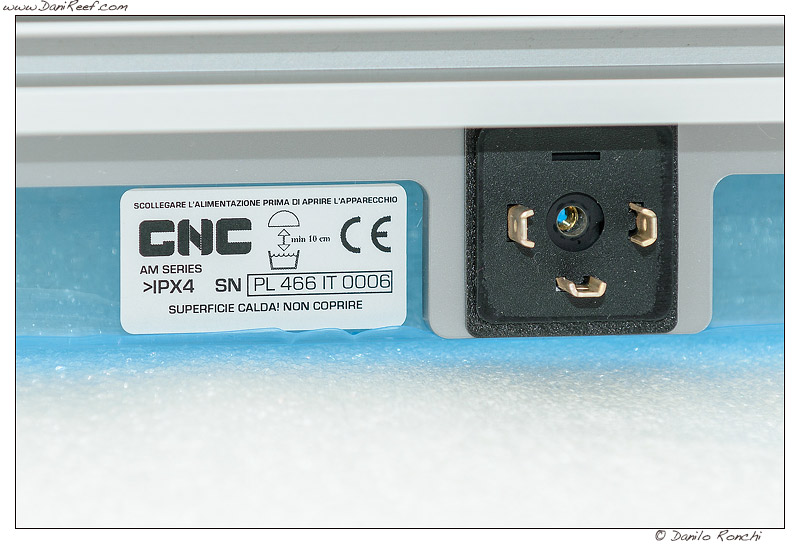 Everything is simplified by the removable back cable, which therefore does not hinder the positioning work. Then once installed simply insert the plug and tighten the rear.
Everything is simplified by the removable back cable, which therefore does not hinder the positioning work. Then once installed simply insert the plug and tighten the rear.
I also note that the power cord is of a light gray color, certainly much more discreet than blacks normally supplied. A good intuition by sicce.
In my aquarium I installed the ceiling at about 30 cm above the water, and I gradually lowered by 5 cm per week until I get about 20 cm. I never changed the photoperiod. No animal showed any symptoms of problems or burns. They are all adapted without further darkening and losses. From this point of view the result was excellent.
Operation
Another feature that distinguishes the sicce 466 from most of its competitors is the lack of a sophisticated dedicated controller. Unlike most of the light fixtures on the market it is not possible to vary the intensity of the LEDs, get a moonlight, or create a specific dimming to our preferences. sicce is dimmable, in truth, but it is only in one mode. Turning on the ceiling, in fact, it performs a LEDs dimming that can be divided into two phases.
In the first half hour only the blue LEDs are turned on, which pass from idle up to 100% intensity, followed in the next half hour by white LEDs, the process last one entire hour, from dark to light. At shutdown the process is reversed by first turning off the white LED’s and then the blue.
All in a extremely simple way.
When did we asked to the designer of the ceiling in regard to this choice of not being able to change the parameters of power and turning on/off, he told us that, since the sicce is aware of the potential of the lamp, with this impossibility to change the parameters of the light, everyone could obtain valid, credible and repeatable results.
To better explain how it works, I invite you to watch the following video where you can appreciate the dimming light switch on and off in a cycle of 3 minutes on and 3 minutes off over a fabulous Acanthastrea lordhowensis. You can not miss the sunrise and sunset from this ceiling on a macro view in high definition.
The latest news about it, but that unfortunately does not provide for use on our ceiling test, speak of a new dimmer that would be able to choose the intensity of the white LEDs, so you can handle a little ‘better all the power of the sicce. In practice, the blue LEDs remain equal and range from the minimum to 100%, by acting on the potentiometer of the new dimmer instead it can lower the power of the white LEDs obtaining therefore a different mixing and then being able to get to have a much more blue light of that we have been accustomed to seeing on our aquarium. But we will talk for sure about it in a future article.
Light coverage
The two ceiling lights have been installed on my marine aquarium with dimensions of 130x60x50 (h) cm. They were installed centered, so every ceiling had to illuminate an area of 65×60 cm. The coverage was total. There were no shady areas and as you can see in the photographs, there are no corals that showed a double colorations due to a different light. So in my opinion it can be used quite safely on aquariums with a surface of 80×80 cm keeping obviously a little ‘higher. Of course for surface of 70×70 kept at 15 or 20 cm in height are absolutely perfect.
Impressions of use
But how is the ceiling? How is its light and how the corals are under it? Below we will show you a fantastic video shot after 10 months of use of this ceiling over my marine aquarium.
My tank is called “Welcome to the Jungle” because I let it grow as Nature prefers. I do not intervene except in rare cases, and what you see is the result of 10 months of wild growth. You may not like it, but this is my baby …
When I installed the ceiling I had problems into my marine aquariums, I had cyanobacteria in different parts of the aquarium, and I had problems with the nutrients that were extremely low, too. Found the “quadrature of the circle” with the nutrients, the aquarium has changed and it grown. What you note with this ceiling is the AMAZING growth of corals. Moreover, in ten months of use I have not lost even a coral for any reason. Perhaps it is not an indicative detail of the quality of the light fixture, but it certainly very important.
As before … enjoy the video in high definition … you will see the sun rise in my aquarium, as for the previous video of Acanthastrea, even here you will see the first blue LEDs going from total darkness to 100% and then white LED’s which add up to the blue going from off to 100%.
Performance and measurements
Difficult to measure the performance of a fixture, probably we do not have the right tools to do it, also it is not even easy to know what to measure. To explore the topic from a theoretical point of view, I invite you to read these articles:
“Coral Coloration and Incident Light: A Photographic Essay” – Departments of Chemistry, Ind. and Manufacturing Eng., The Pennsylvania State University, Ken S. Feldman, Lauren F. Vernese, Elizabeth A. Huber, Kelly M. Maers, Matthew R. Test (Marzo 2008)
“Glitter Lines: More Than Aesthetic?“, By Dana Riddle (Maggio 2006)
“How Much Light?! Analysis of Selected Shallow Water Invertebrates“ Light Requirements, By Dana Riddle (Marzo 2007).
“Underwater Light Field and its Comparison to Metal Halide Lighting” By Sanjay Joshi (Agosto 2005)
The first tool I used was the lux probe attached to Seneye Reef system that we reviewed recently. I made two measurements, the first measurement was made on the first day of installation of the ceiling, 30 cm away from the water, with the probe in the water-free surface and in the center of the light from fixture.
I measured 516 Par and 19,059 Lux, accordingly with the previous screenshot.
After 10 months of testing I re-measured values, but this time I had already placed the fixture at about 20 cm from the aquarium’s water.
The Par has increased to 696 while the Lux to 25,697. In both cases an increase of 35 %. The spectrum shown by the thick line that changes color is not detected on the ceiling , but a reference PAR curve, which makes us understand the most important colors for photosynthesis of plants are those about 440 nanometers and about 660 nanometers. The dotted line, always colorful, shows us how our eye is sensitive to light, and shows us how we are much more sensitive to green light. Finally, the white – gray line shows the spectrum of or fixture, the sicce GNC AM 466 detected on three points across the spectrum, so it is far from complete.
What’s important, now, is the fact that after 10 months, and approaching the ceiling to water, values have increased, not decreased.
Below I have also used the light probe of the Elos Biotopus II and I found the following values:
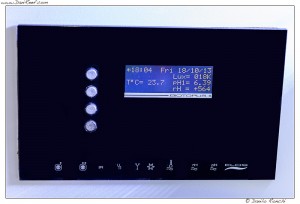 | 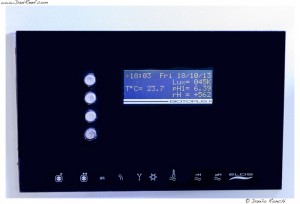 |
| Measurement at the side of sicce, about 20 cm away Lux: 18.000 | Measurement at the center of sicce, about 20 cm away Lux: 45.000 |
These values alone are difficult to interpret, because the probe is not calibrated, but can be interesting when taken in conjunction with a comparison. You can still quick to point out how the Lux are gone from 25,690 from Seneye to 45,000 of the Biotopus II. So I think the measures assessed only for direct comparisons, in the absence of a calibrated instrument that I hope to have soon. But that’s another story. Most likely the discriminant is the cone angle of detection of light, very tight in the probe of the Biotopus and much wider in the Seneye, so a focused beam like that of HQi assumes much more importance with the Elos probe.
I was, however, measured the performance of my old 250 watt HQI, using a brand new Elos Spectra 14.000 K. The measured values were then equal to 60,000 and 71,000 respectively. A theoretical loss of illumination equal to 37 % to 70% in the center and the edge of the fixture.
Judging from these data, the comparison should not be put and instead… The aquarium as it was when the sicce GNC AM466 was installed:
The marine aquarium as it is today
The difference is 10 months, including a summer in the middle, which is definitely the most critical period for any marine aquarium.
The results are right before your eyes. The angle is different, unfortunately, but coral growth has been incredible, as well as their change in coloration. The Acroporas came to the water’s edge when in the first photos were missing more than 15 cm.
Maintenance cost
One of the questions to be resolved regarding the advisability of LED ceiling lights compared to traditional HQi or T5, is about the cost of purchase and maintenance.
We have already seen that or a pair of sicce GNC AM 466 costs 3,184 Euros MSRP, in Italy.
The power consumption is declared equal to 120 watts per fixture , then a ratio of cost/watt of 13.3 euro per watt. To get a comparison with a system that I know very well, the Elos E-Power 250 watt, now no longer in production, had a list price of 1.800 Euros with 2 lamps and Elite, 565 watt, which has a much more economical 3,2 € per watt. In this context therefore the passage from HQi to LED leads us to a cost increase of over 400%. Anyway, we have to consider that a good part of the power of the HQi lamps are lost and dissipated into heat, having less efficiency of LED systems.
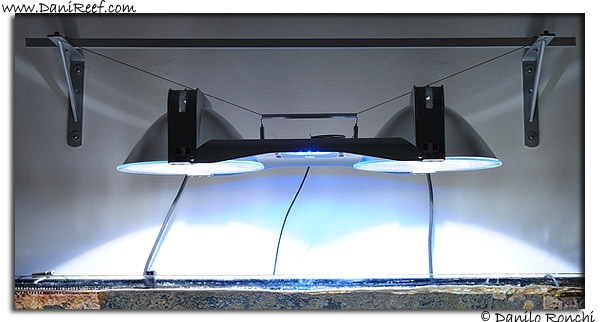 We must also consider the fact that during its operation the LED fixture has no need of having to change anything. Here we talk about ceiling lights that should last up to 10 years of operation, while any T5 or HQI fixture requires a continuous exchange of lamps.
We must also consider the fact that during its operation the LED fixture has no need of having to change anything. Here we talk about ceiling lights that should last up to 10 years of operation, while any T5 or HQI fixture requires a continuous exchange of lamps.
If we take for example the lamps Giesemann Megachrome Coral 250 watt, in Italy they cost 85.40 € each, and if we thought to replace every 9 months we would have in fact an increased cost of 228 euro per year (85.40*2/9*12).
Now let us look at the comparative costs between the use of the LED ceiling light sicce GNC AM466 and the Elos E-Power 250 watt analyzing the consumption of my electric bill during the two periods from January to August 2012 and from January to August 2013, which are homologous to compare.
Obviously, this table can not be exhaustive because we must also consider the consumption of the house and everything else, but can be very indicative. The difference between the two solutions in fact amounts to 20%. A number, in my opinion, extremely important .
The HQI system had a declared power consumption of 565 watts, compared to 240 watts of LED system. A difference of about 565-240 = 325 watts per hour of operation. Given these numbers, and considered in 243 days of trial, the difference, purely hypothetical, between the two consumptions would have to be 325*10* 243/1000 or equal to 790 kwh.
The difference that we have extrapolated from the measured consumption of our bills was 786 kwh.
The similarity of the two numbers which can only reinforce the validity of our hypothesis. The savings measured is extremely close to that calculated. And it’s interesting to note one thing. Comparing the consumption during the months when the heater probably has never turned on, as May, the difference was 3 kWh per day, while in January, the coldest month and the theoretically worst for the LEDs, the savings was almost 5 kwh. Obviously , however, we must also consider that my aquarium is maintained in winter to 22.7 ° minimum.
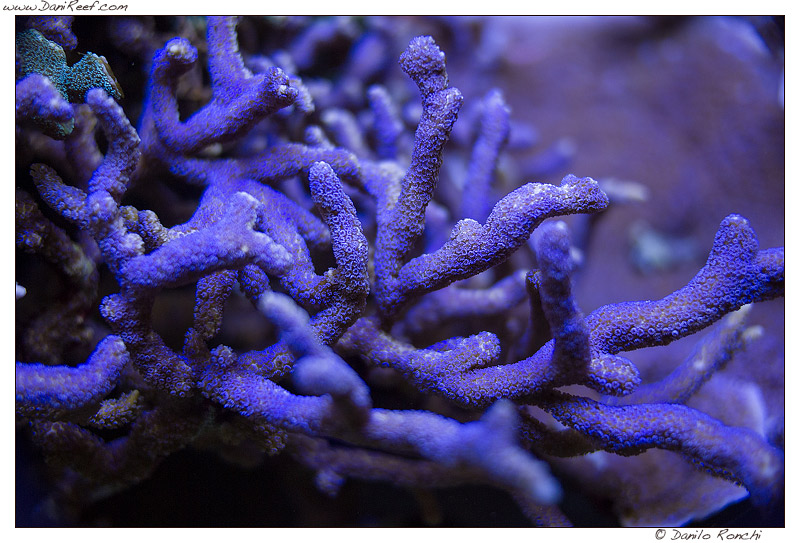 Purple Montipora under the Sicce GNC AM466
Purple Montipora under the Sicce GNC AM466
In addition to this, however, we also see our measurements performed with the clamp meter, since, as we know, all light fixtures to be sold in Italy should have cos(fi)=1, the measurement should be very real.
 |  |  |
| light off Dispersion measured: 0.043 A Measured consumption: 0.043*224=9.63 watts | Ceiling lamp dimming Measured current: 0,304 A Measured consumption: 0.304*224=68.10 watts | Ceiling lamp completely switched Measured current: 0.582 A Measured consumption: 0.582*224=130.37 watts |
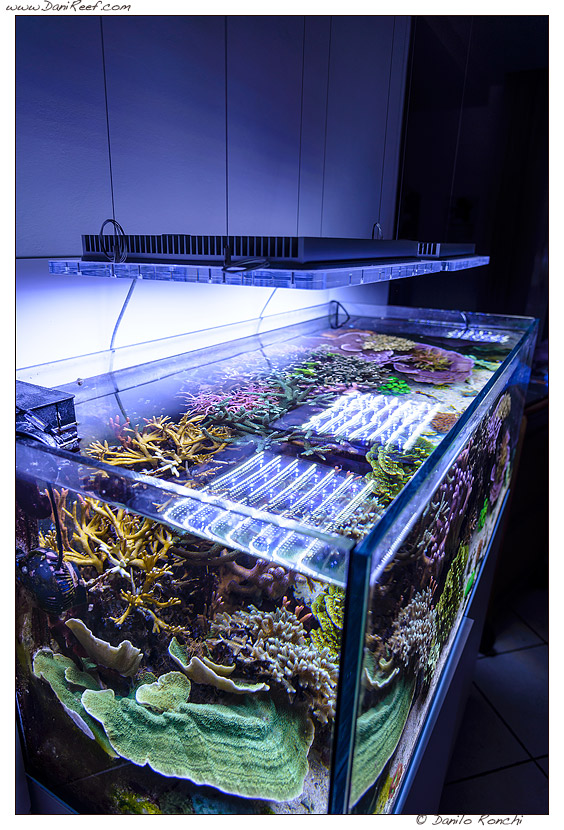 We used a voltage of 224V to make the calculations because we measured that value during the test, instead of the canonical 220V .
We used a voltage of 224V to make the calculations because we measured that value during the test, instead of the canonical 220V .
Having said that we can make some interesting considerations.
The first consideration that catches the eye is that our two ceiling lights, the subject of the test, showed a small dispersion of about 10 watts per fixture. We performed measurements on both, and the value was virtually identical. If not properly set under timer, a pair of similar ceiling would have led to a dispersion of about 230 watts per day, that in the ten months of our test means 56kwh, or about € 14, or € 1.4 per month. Virtually nothing, however we like to report it. We can not know if all the light fixtures suffer from this minor flaw, however, in the absence of more precise data I would advise you to put under timer the power units .
The second consideration is that consumption is very low compared to the light emitted by sicce GNC AM466, 130 watts measured in our test are extremely close to declared value, probably obtained with a voltage lower than ours.
In theory we would have to add consumptions related to the two dimmer, but we have failed due to the impossibility of being able to measure the cos(fi) and considering them irrelevant anyway in the final speech.
In comparison with HQi the difference is really high.
The question we set ourselves was about the affordability of the transition from the HQI lamps to LED, taking into account the two lamps that we had at our disposal, the Elos E-Power with Manta system and a pair of sicce GNC AM466.
In five years of using the sicce GNC AM466 would have the following costs (if it was that electricity does not increase in the coming years):
- Cost of purchase: 3.200 €
- Annual maintenance cost for 10 hours of illumination: 876 kwh * 0:26 = 228 €
- In five years: € 4,340 (€ 5,480 in 10 years)
While a HQi ceiling lamp, as the Elos, would have the following costs :
- Cost of purchase : 1.800 €
- Annual maintenance cost for 10 hours of illumination: 2062 * 0:26 kwh = 536 €
- Average cost of replacement lamps annually, calculated over a period of 9 months : 228 €
- In five years: € 5,620 (€ 9,440 in 10 years)
For the sake of comparison, you might also consider a possible T5 ceiling lamp, like the ATI powermodule with 8 tubes of 54 watts:
- Cost of purchase : 800 €
- Annual maintenance cost for 10 hours of illumination: 1577 * 0:26 kwh = 410 €
- Average cost of replacement lamps annually, calculated over a period of 7 months : 17 * 8/ 7 * 12 = 233 €
- In five years: € 4,015 (€ 7,230 in 10 years)
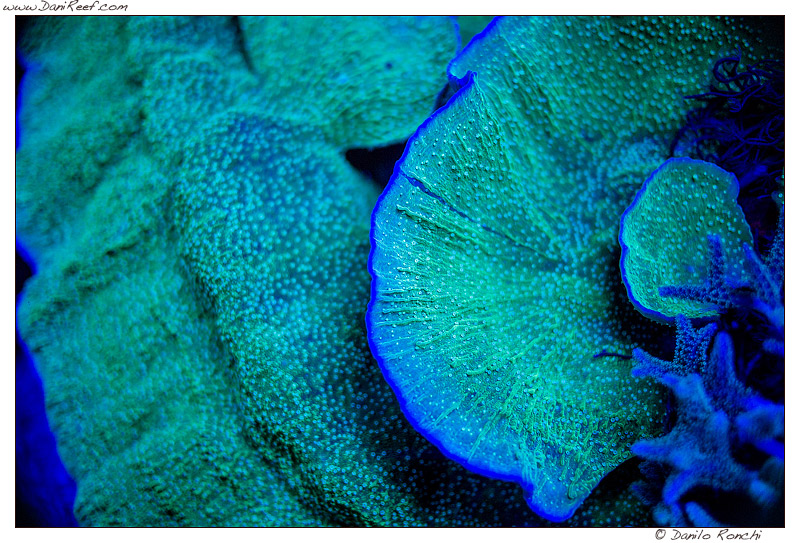 Green Montipora foliosa under the blue LEDs of the Sicce GNC AM466
Green Montipora foliosa under the blue LEDs of the Sicce GNC AM466
 Obviously the speech to do would be much more complex. On the one hand we might already have a ceiling light over our marine aquarium (indeed we do), and so we should consider the purchase cost of ceiling led on the one hand and do not consider the purchase cost of ceiling already in our possession.
Obviously the speech to do would be much more complex. On the one hand we might already have a ceiling light over our marine aquarium (indeed we do), and so we should consider the purchase cost of ceiling led on the one hand and do not consider the purchase cost of ceiling already in our possession.
In addition, the table above does not take into account the costs of heating and cooling.
We make an impact. At my house, during winter, temperature is between 19 and 20 Celsius degrees, and the temperature in the aquarium is kept at 22.7 Celsius degrees minimum. Under these conditions, the heater would turn on very few times even with the LEDs, as shown in the table consumption measured, while it grows up, paradoxically, the summer consumption, because the fans, used instead of the chiller, worked well but some day have found themselves in trouble and I was forced to make greater use of home air conditioning, which consumes obviously well above the chiller.
However, the energy savings have been substantial.
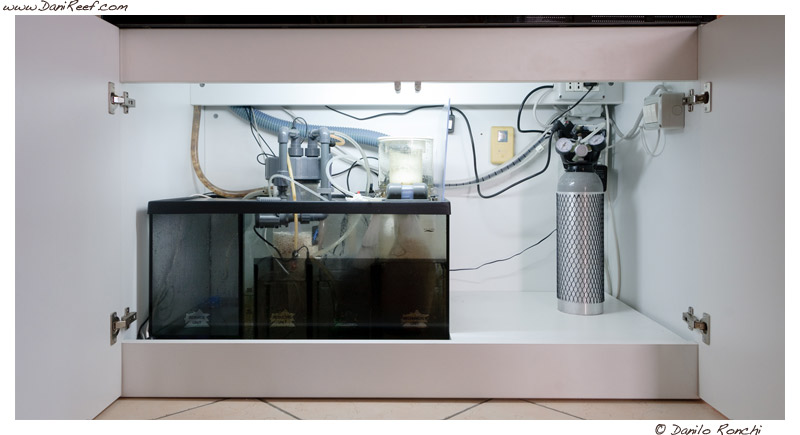 | 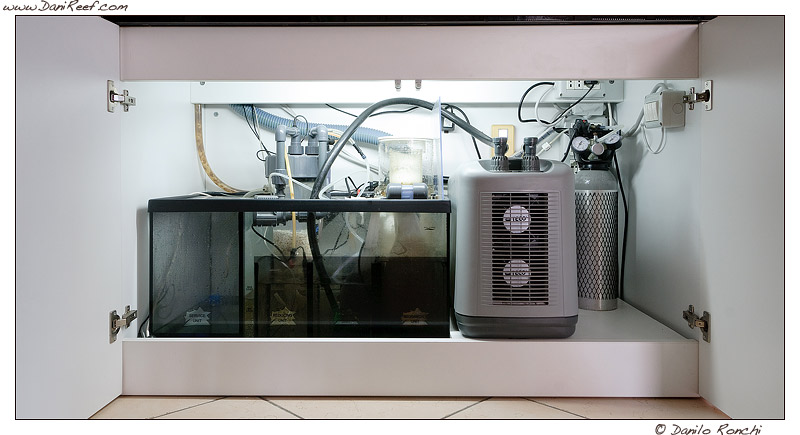 |
| Aquarium case with LED and without chiller | Aquarium case with HQi and chiller |
In any case, in my particular case, I could do without the chiller, which could still be a purchase to consider. Or, seeing it in a different way, with the HQi you need a chiller very powerful, with LED, as the sicce GNC AM466, you might think about buying a much smaller chiller to use in conjunction with the fan to cool down the aquarium, or you could think of not having to buy it, not using it as I did.
Is it therefore worth today, leave the lamps used for our marine aquarium, to use LED technology? Our answer is found in the last paragraph … conclusions
Conclusions
We arrived at the bottom. In January we had made three questions:
1) The LED technology is mature enough to supplant the HQi (and T5)?
Yes, it is, without a doubt. With a ceiling light as the sicce GNC AM466 I replaced the previous HQi dramatically improving the growth of corals and getting a substantial balance in color. And this is really a great compliment.
2 ) The cost of purchase and operation of a ceiling light LEDs are comparable, smaller or bigger than a fixture, similar to “result”, in the aquarium but with different technology?
Considering the costs, high, of LED ceiling, we get a draw with the HQi ceiling after about 3 and a half years, while it takes six years to break even to a T5 system. If we did not consider the cost of purchase instead of any ceiling that we already have the break-even is reached around 6 years for a 2×250 watt HQi ceiling light with blue LEDs and 7 and a half years for a T5 8×54 watt ceiling light.
But yes. It is still worthwhile. Because you will not be forced to purchase a chiller, if you do not live in areas that have a high average temperature, as the south Italian. You will not have a fast decay of the bulbs that obviously conditioned the aquarium and its guests, and you will not have to think about something to replace every few months. This last consideration alone could be worth the purchase.
Also in the 10 months that I have used the sicce GNC AM466 I have not found any problem, no LED had problems.
3) The measured values of consumption and brightness will be constant over time?
In the 10 months since we had the sicce on our marine aquarium we did not detect any problems. Rated consumption has not risen, nor we have had less detectable light. Indeed lowering the fixture we measured an increase of 35%. So definitely there will be a decrease over time, because it is physiological, but we do not absolutely have warned. With ceiling light LED you pay once, but then you do not pay anything, and with increases in electricity costs you could savings much more.
But remember that the game is worth the candle because the results over our corals are comparable, if not better, than those obtained with a HQi 2×250 watts ceiling light, otherwise every other speech would be meaningless.
We then come to the end, and I think that what is stated in the text is enough to make you understand we liked it very much this fixture. It has proved powerful, without any problem, except that slight leakage at night we have highlighted, easy to use, maybe too much, and the corals have responded great.
Unfortunately, the purchase cost is remarkable, and surely this barrier will take away many aquarists, but, in our view, is amply justified by the technology and the results obtained.
Aside from the cost, which however is never secondary in this kind of purchase, the problems of this ceiling are only two:
- The lack of reflection in the water, like HQi lamps or other LED system with less LEDs but with more Power for each LED.
- The lack of the ability to choose different shades of the LEDs. With sicce GNC AM466 we are stuck with the choices of the manufacturer. Today you can not give more importance to the blue as it is not possible to increase the red or green. In the future it will be possible to intervene in some way, as we have seen, but today you can not do it.
The ceiling is this and you must like this as it is, in its extreme simplicity. But if you don’t miss the shades of color, if the lack of glitter lines should not be an insurmountable problem for you, and you have no problem accepting that you can not intervene in various shades… you could not go wrong … you will have a ceiling light simple, powerful, excellent for corals.
I would also add, and I do not think it was an accident, that during the ten months that I had in the test sicce AM466 I’ve had for three consecutive days the release of planulae from my corals, index of general corals health, due particularly from the light, true engine of our marine aquarium.
In my opinion this could be considered a definitive fixture.
We thank sicce, especially Federico Carraro and Emanuele Candini, for putting at our disposal the sicce GNC AM466 for 10 months in order to be able to do this depth review.

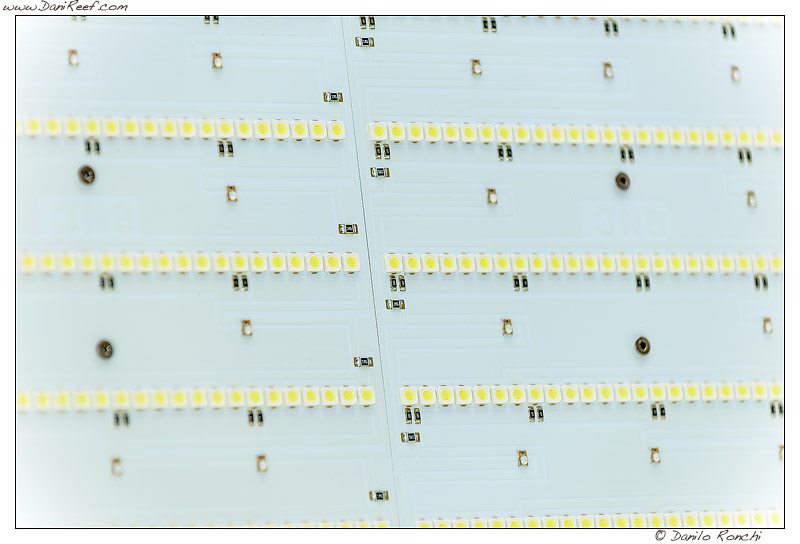

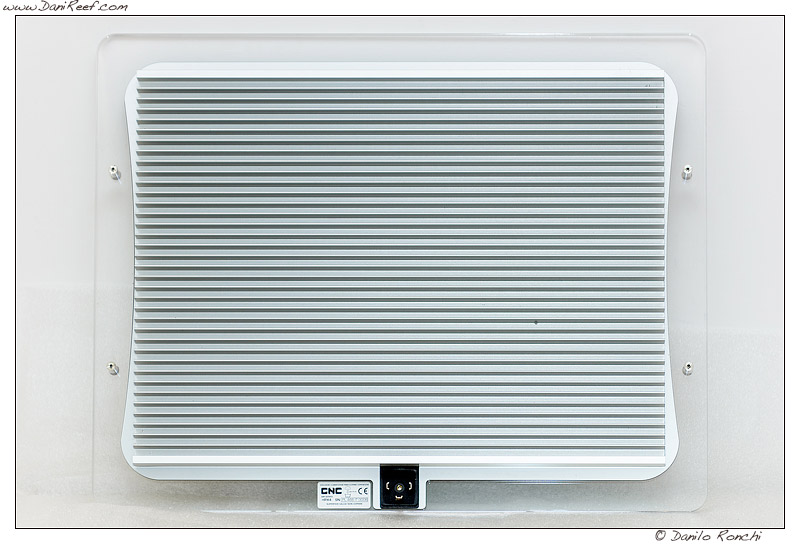
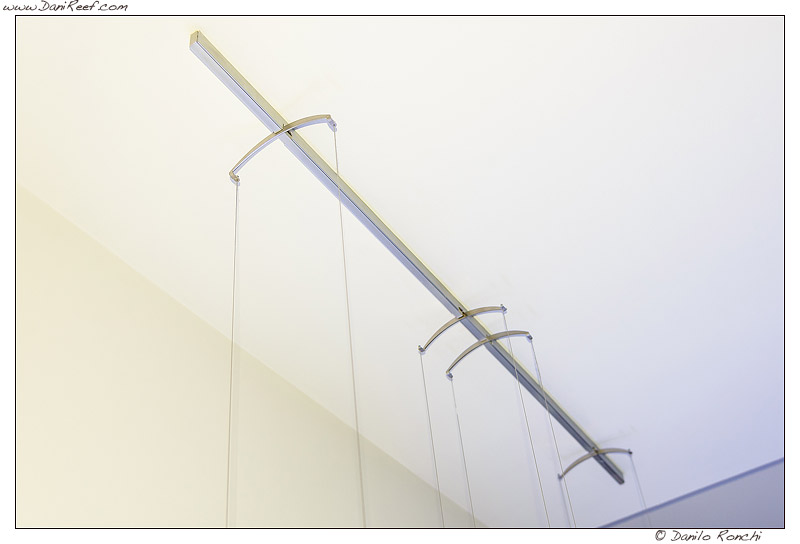

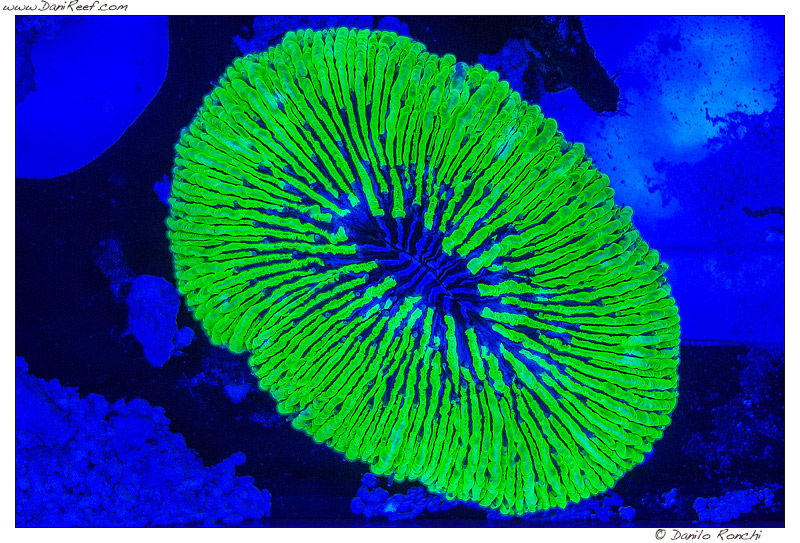

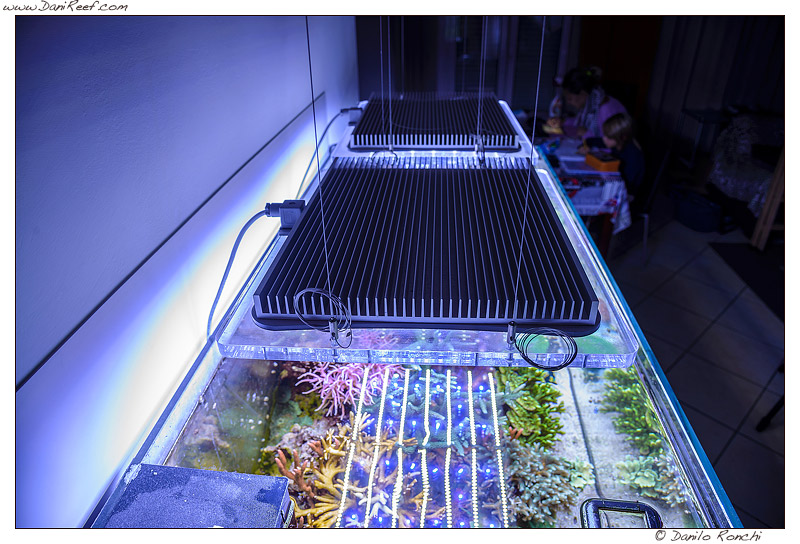
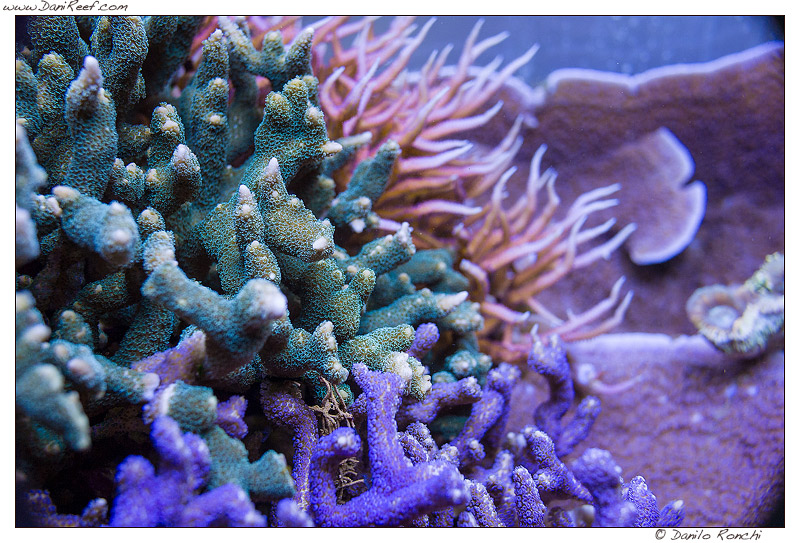
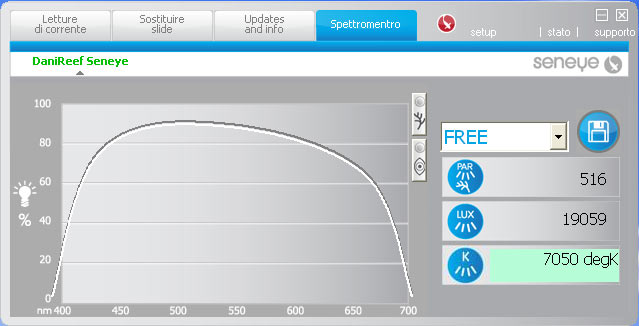
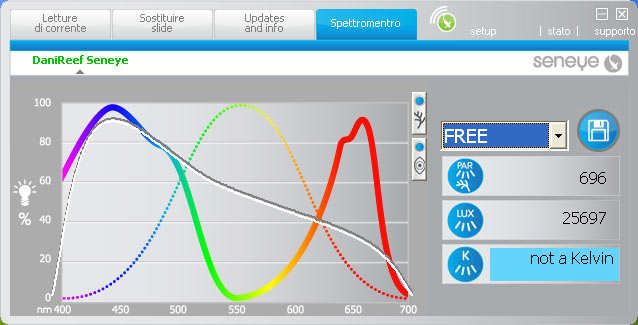
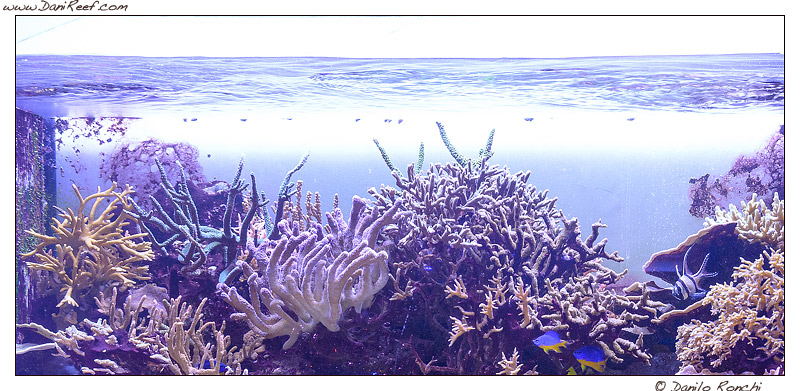
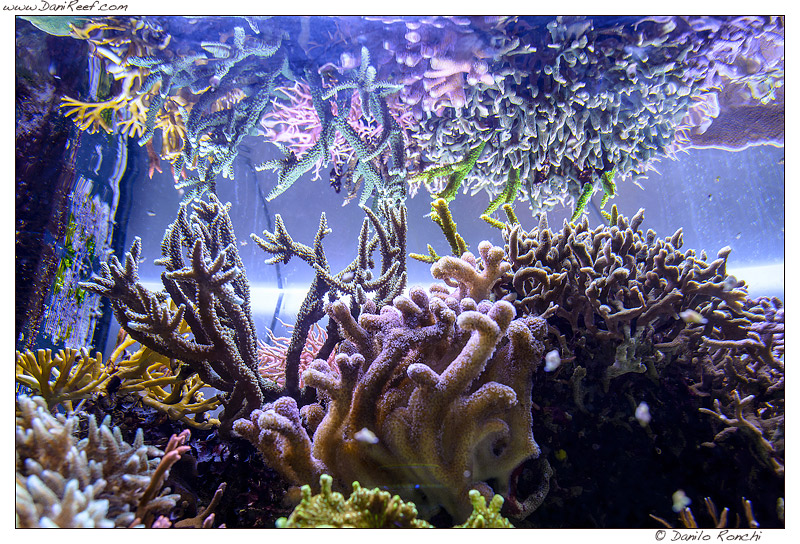



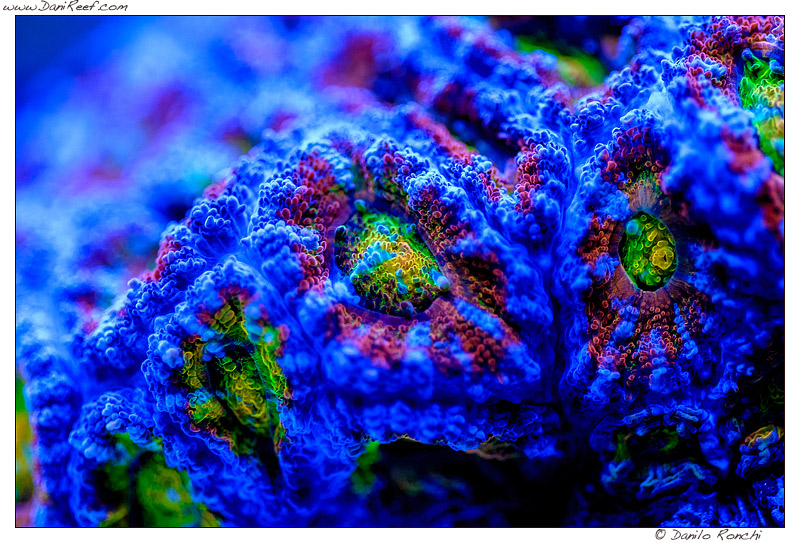
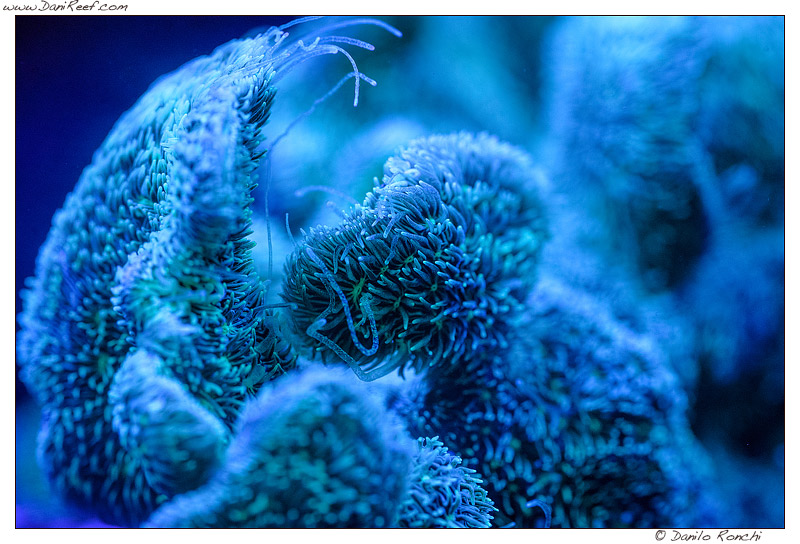
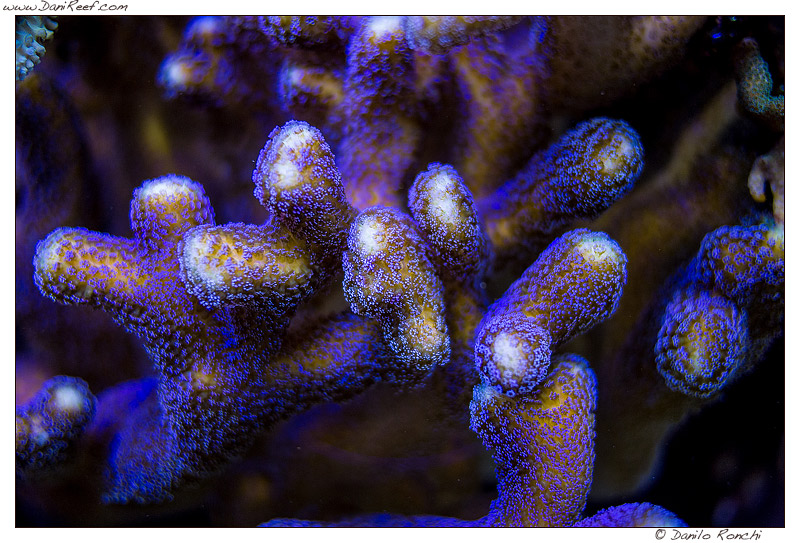
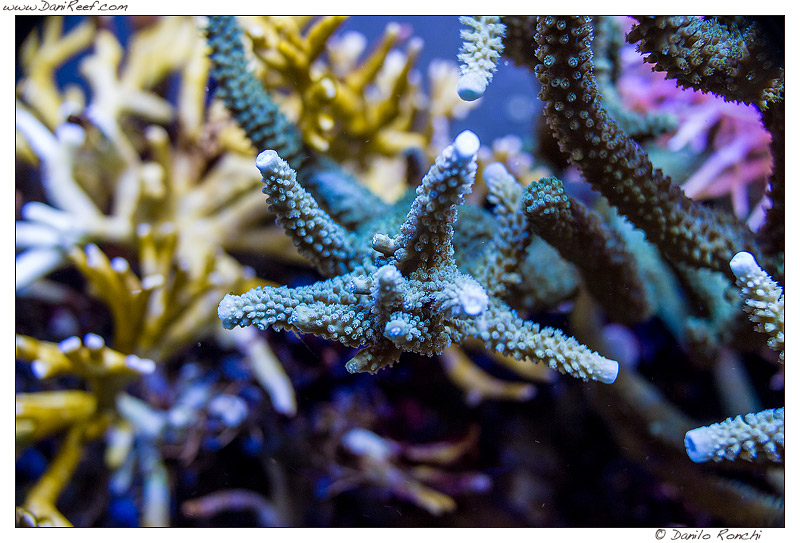
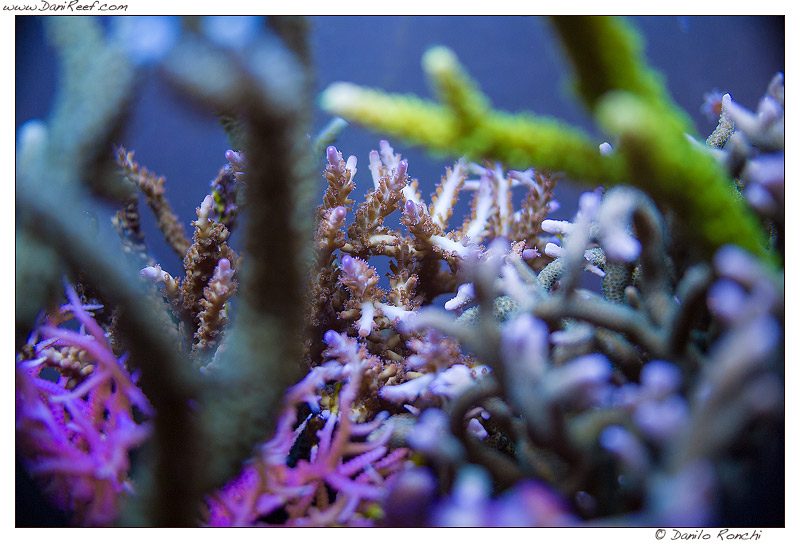








0 Comments